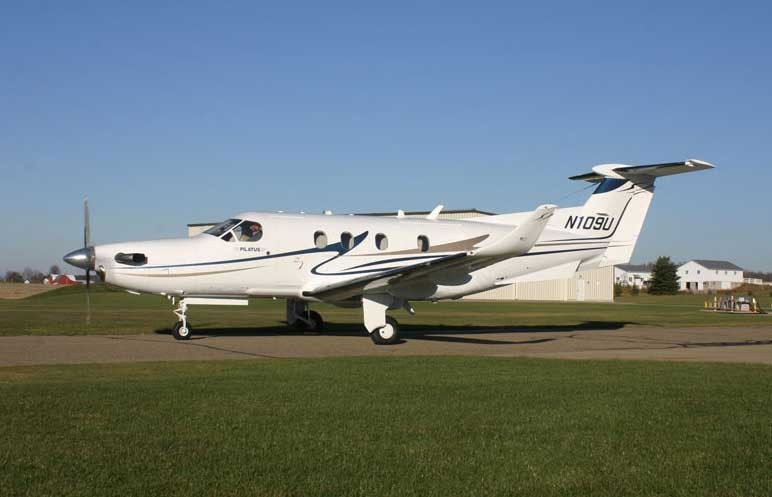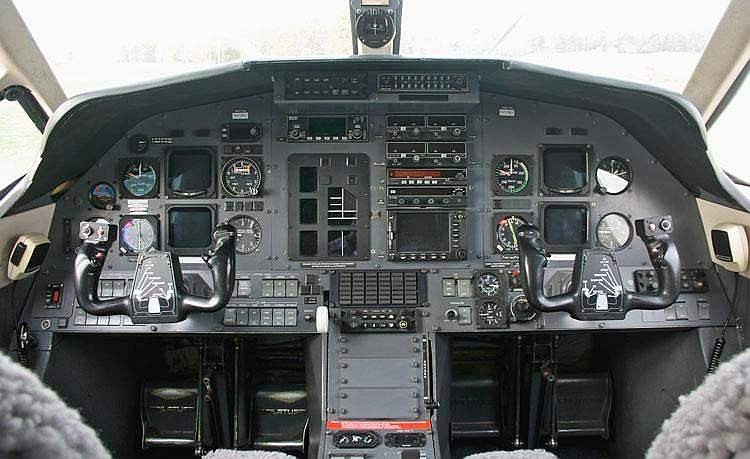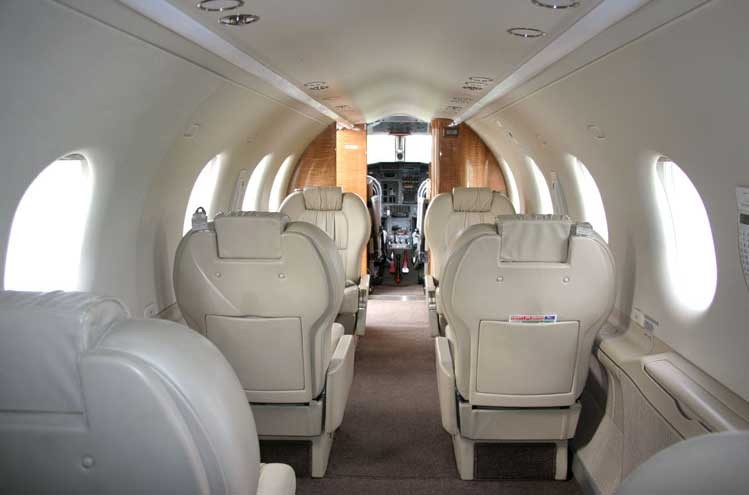


Aircraft Description
Background/History
At the 1989 NBAA convention in Atlanta, Pilatus showed a mock-up of their latest project, the single-engine turboprop PC-12. The new aircraft was aimed at the developing market for large single-engine utility aircraft to serve such roles as small-package delivery and short-range business travel. The PC-12 accomplished its first flight in May 1991and demonstrated a level of performance that exceeded that of its major competitor, the Cessna Caravan, in range, cruise speed, and climb rate. The PC-12 shows evidence of its lineage in the short-field capability that was the hallmark of Pilatus’ earlier PC-6 Porter and Turbo Porter series. Unlike the high-wing, taildragger PC-6, the sophisticated PC-12 is a sleek low-wing monoplane with retractable gear. Its role as a utility plane is somewhat disguised by the jet-like appearance of its T-tail and winglets, its swift speeds, and its high-tech EFIS and avionics suite. The Pilatus PC-12 received FAA certification in July 1994, and by December 2000 more than 253 examples were flying with production continuing at a steady rate. As of 2006, there have been 610 aircraft produced.
Power
At the 1989 NBAA convention in Atlanta, Pilatus showed a mock-up of their latest project, the single-engine turboprop PC-12. The new aircraft was aimed at the developing market for large single-engine utility aircraft to serve such roles as small-package delivery and short-range business travel. The PC-12 accomplished its first flight in May 1991and demonstrated a level of performance that exceeded that of its major competitor, the Cessna Caravan, in range, cruise speed, and climb rate. The PC-12 shows evidence of its lineage in the short-field capability that was the hallmark of Pilatus’ earlier PC-6 Porter and Turbo Porter series. Unlike the high-wing, taildragger PC-6, the sophisticated PC-12 is a sleek low-wing monoplane with retractable gear. Its role as a utility plane is somewhat disguised by the jet-like appearance of its T-tail and winglets, its swift speeds, and its high-tech EFIS and avionics suite. The Pilatus PC-12 received FAA certification in July 1994, and by December 2000 more than 253 examples were flying with production continuing at a steady rate. As of 2006, there have been 610 aircraft produced.
Avionics
The PC-12 can be equipped with either a standard AlliedSignal two-tube EFIS 40, or optional AlliedSignal four- or five-tube EFIS panels with the KFC 325 3-axis autopilot. Bendix/King supplies dual KX155 navcoms, the KN62A DME, KR87 ADF, and KT71 transponder. The engine instrument system or EIS is a liquid crystal display of both analog and digital engine and system readouts. On recent aircraft the RDR 2000 radar is installed in place of the RDS82 VP radar found on earlier aircraft.
Design Features
The Pilatus PC-12 is a single-engine turboprop powered, pressurized, business/utility aircraft configured as a cantilever low-wing monoplane with a cantilever T-tail. The retractable tricycle landing gear utilizes trailing-link main gear struts, and has a single wheel on each unit. The airframe is constructed primarily of aluminum, but composite materials are used for some components. In addition to the typical airstair door just aft of the flight deck, a port-side cargo door measuring 52″ x 55″ is located aft of the wing. Operational features include automatic torque limiting, automatic fuel load balancing, and a stall-warning stick shaker/stick pusher system.
Accomodations
The PC-12’s interior can be configured for a variety of missions. The aircraft is offered in a standard seven passenger executive layout version with an aft lavatory. High-density seating would add two additional passenger seats and with the co-pilot seat on the flight deck available if desired. Also available are a freighter version, or a combination arrangement in which the forward section of the cabin houses four passenger seats and a large cargo area occupies the aft section of the cabin. A number of the aircraft have had interiors completed in an air ambulance configuration. Cabin dimensions are 4.8ft. in height, 5.0ft. in width and 16.9ft. in length.
| General | PC-12 | |||
|---|---|---|---|---|
| Category | Single-Engine Turboprop | |||
| Years Aircraft Manufactured | 1995 – 2006 | |||
| Serial Number Range | 101 – 773 | |||
| Retail High Price | $3,000,000.00 / 2,354,100.00€ | |||
| Retail Low Price | $950,000.00 / 745,465.00€ | |||
| Characteristics | PC-12 | |||
| Seating | 1 + 7/10 | |||
| Wing Loading | 35.7 | |||
| Power Loading | 8.3 | |||
| Noise(EPNdB): Takeoff/Sideline/Approach | 74.3 | |||
| External Dimensions (ft) | PC-12 | |||
| External Length | 47.3 | |||
| External Height | 14.0 | |||
| External Span | 53.3 | |||
| Internal Dimensions (ft) | PC-12 | |||
| Internal Length (Overall/Net Height) | 16.9 | |||
| Internal Height | 4.8 | |||
| Internal Width (Max/Floor) | 5.0 | |||
| Baggage | PC-12 | |||
| External: Cu.Ft./Lb. | N/A | |||
| External: Cu.Ft./Lb. | N/A | |||
| Power | PC-12 | |||
| Engines | P&WC PT6A-67B | |||
| Output (lbs ea.)/Flat Rating | 1,200shp/ISA+36 deg | |||
| Inspection Interval | 3,500t | |||
| Data based on latest manufactured year | ||||



